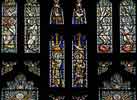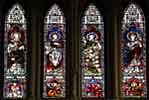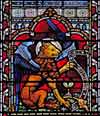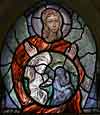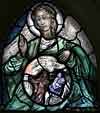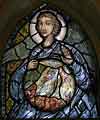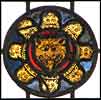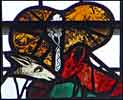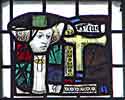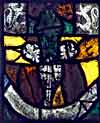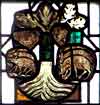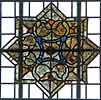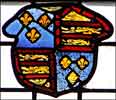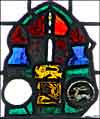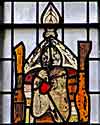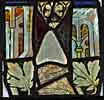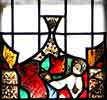For this church:    |
|
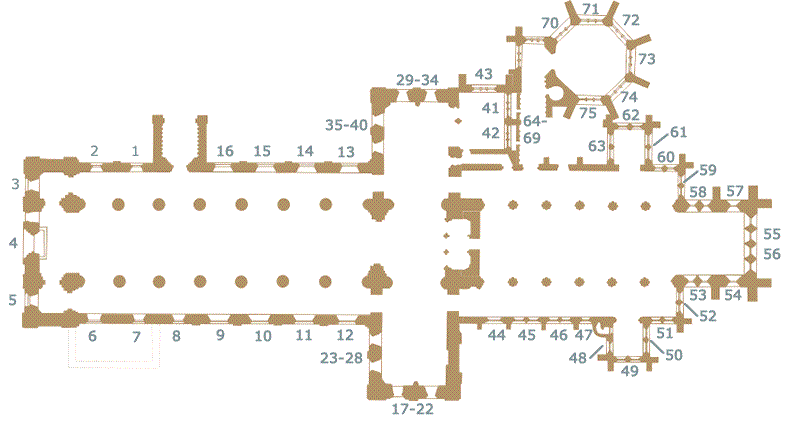 |
Key to Glass |
Nave
The windows are numbered from the north porch, working westward: |
 Suffer the little children Suffer the little childrento come unto me |
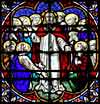 Christ Christ preaching |
 Christ among the doctors Christ among the doctors |
The glass in the Norman window to the west of the north door is by William and Arthur O’Connor. It is so signed at the bottom right hand corner and dated 1851. It was exhibited at The Great Exhibition of 1851 before installation in the minster and won an award.
There are three sections, showing, from the bottom:
 Christ among the doctors
Christ among the doctors
This shows the occasion when Jesus was inadvertently left behind in the Temple after The Feast of the Passover. One of the doctors is consulting the scriptures and one is disputing a point. Mary and Joseph have just returned to the Temple.
 Christ preaching
Christ preaching
Christ is surrounded by the Apostles and the theme of disputation continues. The kneeling figure, who appears to be asking a question, may be St Peter.
 Suffer the little children to come unto me
Suffer the little children to come unto me
Jesus is shown with a child on his knee and he has his right hand raised in blessing.
Within the window there are four steps from the string course to the glass. They are inscribed:
 Hanc Fenestram
Hanc Fenestram
 Cars Fletcher Cleric AM
Cars Fletcher Cleric AM
 Restauravit
Restauravit
 AD mdcccl
AD mdcccl
On a brass tablet beneath the string course:
In Honorem DEI |
 |
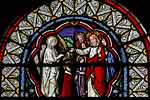 Raising of Lazarus Raising of Lazarus |
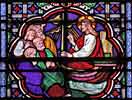 Preaching from Preaching froma Fishing Boat |
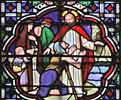 The Healing The Healing at Bethesda |
The glass in this window, which is the only original unrebuilt Norman window in the minster is again by the O’Connor brothers and was made in 1851. Again, there are three sections:
 The Healing at Bethesda
The Healing at Bethesda
In the lower roundel, the cripple kneels in the foreground with a crutch in his right armpit. Christ stands in the centre of the panel in a white robe with a red overmantle.
 Preaching from a Fishing Boat
Preaching from a Fishing Boat
The centre roundel shows Christ preaching from a boat, which he did more than once. This, however, must be the earliest such occasion, when he was about to recruit the first Apostles. They can be seen on the left, but they do not yet have haloes.
 Raising of Lazarus
Raising of Lazarus
The top roundel shows Jesus with his left hand raised in blessing and his right hand stretching out towards Lazarus. Mary and Martha kneel between Christ and Lazarus.
On a brass tablet beneath the string course:
This Window is dedicated |
 |
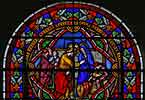 The Marriage The Marriage at Cana |
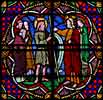 St John Baptist St John Baptist recognizes Christ as Messiah |
 Temptations of Christ Temptations of Christ |
The glass in this window, under the tower in the north-west corner of the nave, is again by the O’Connor brothers. Its date is recorded as 'circa 1851'. The three sections are:
 Temptations of Christ
Temptations of Christ
In the lower roundel, Jesus is confronted by the Devil, in the guise of an old man with evil eyes and a clawed foot.
 St John Baptist recognizes Christ as Messiah
St John Baptist recognizes Christ as Messiah
The two figures occupy the centre of the panel, with Jesus in red and John in his camel-skin.
 The Marriage at Cana
The Marriage at Cana
Christ and his mother have central positions, with a servant filling the water jars on the right and some of the wedding guests on the left.
4.The Great West window
This window was conceived by Martin Stancliffe, the then Minster Architect and the glass was painted by Patrick Reyntiens and prepared for installation by the Barley Studios, York, in 1996. The glass forms an angel window, representing angels as beings of light. The window, whilst firmly rooted in the medieval traditions of stained and painted glass, involves a contemporary reworking of those traditions. The colours and textures were carefully chosen to be similar to those used in the mid-fifteenth century when the window itself was inserted in the Norman west wall. The design of the glass allows the tracery to be enhanced in ways that were not possible when common glass only was present.
In the seven lower panels, angels hold spheres in which are seen the seven acts of creation: (from the left) the creation of light, the vault of the heavens, dry land appearing out of the waters, day and night, the birds and the fish, living creatures on the earth, and human beings.
At the bottom of the lower panels are seven scenes showing interventions by angels as recorded in the Bible: (from the left) the expulsion from the Garden of Eden, Jacob wrestling with the angel, the story of Tobias, who holds the golden fish, the Annunciation, angels ministering to Christ in the wilderness after his temptation, the Agony in the Garden of Gethsemane, and Easter Day (showing an angel and two Marys at the tomb).
Further angels, also holding spheres, occupy six of the seven panels in the centre of the window. The Virgin appears in the centre panel with a blue nimbus and holds seven red flashes depicting The Seven Sorrows of Mary.
The upper part of the window is less directly representational, with many angels of various sorts merging into the myriads of the heavenly host. At the very top of the window can be seen the Godhead, with the Hand of God reaching down. To either side are alpha and omega.
The window is protected by isothermal double glazing. On the outside of the coloured window is a clear glass window with identical leading, exposed to the elements on the outside of the building. The inner painted window is inside the building, with space for air to circulate around both its sides: in this way a stable temperature is maintained and condensation is avoided. The identical leading of the two windows can only be superimposed from one ideal point within the nave, but any slight mismatch only serves to enhance the sense of depth experienced by the viewer.
 |
 The Flight The Flight into Egypt |
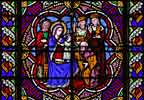 The Adoration of The Adoration of the Magi |
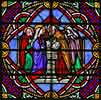 The Presentation The Presentationin the Temple |
This window is under the south-west tower and once again is by the O’Connors, circa 1851. As with all the O’Connor windows, it features three roundels and a patterned border. The scenes are:
 The Flight into Egypt
The Flight into Egypt
In the upper roundel, Joseph leads the ass bearing Mary and Jesus, whilst an angel hovers protectively above.
 The Adoration of the Magi
The Adoration of the Magi
In the central roundel, Mary can be seen holding the Christ-child on her knee, with Joseph standing behind, whilst the three Kings, one kneeling, offer their gifts to the infant.
 The Presentation in the Temple
The Presentation in the Temple
There appears to be a font in the foreground and the intention may be to associate the event with naming.
 |
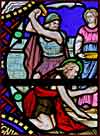 Martyrdom of Martyrdom of St John the Baptist |
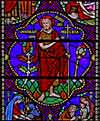 Behold the Behold theLamb of God |
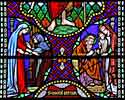 Visitation and Visitation andthe naming of St John the Baptist |
Yet another O’Connor window, dated circa 1851. There are three roundels, but the upper and lower ones are divided to show two scenes each:
 St John Baptist before Herod (Left)
St John Baptist before Herod (Left)
John had incurred the wrath of Herod for criticising the King over a relationship with his brother’s wife Herodias. Here the Baptist preaches to Herod.
Martyrdom of St John the Baptist (Right)
John has been imprisoned by Herod. Salome, the daughter of Herodias, dances before the King and is asked what reward she would like. She asks for the head of John. The executioner is shown with his sword.
 Behold the Lamb of God
Behold the Lamb of God
In the centre panel, John the Baptist is shown with the legend 'Behold the Lamb of God who takes away the sins of the world', words first spoken by John upon seeing Jesus approaching for the first time.
 Visitation (Left)
Visitation (Left)
Mary greets her older cousin Elizabeth, having heard that the latter has conceived a son.
The Naming of St John Baptist (Right)
Zechariah, having been struck dumb for not accepting that Elizabeth was to bear a child, writes 'His name is John' and regains the power of speech on the instant.
 |
 The Baptism of Christ The Baptism of Christ |
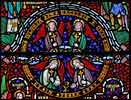 Glory to God Glory to Godin the Highest |
 Annunciation Annunciation to the Shepherds |
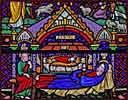 Nativity of Christ Nativity of Christ |
This is the baptistry window, to the south of the font. Another work by the O’Connors, circa 1851. This window has five sections:
 The Baptism of Christ
The Baptism of Christ
The uppermost panel shows the baptism in the traditional way, with John the Baptist in his camel skin administering the rite.
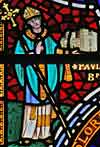 St. Paulinus baptizes St. Paulinus baptizesin the River Trent |
St. Paulinus baptizes in the River Trent
The Venerable Bede tells how Paulinus (The first Bishop of York) baptized people in the Trent and there is a tradition that it was near to Southwell. This section of the window shows Paulinus on the left and people approaching from the right. Between them is a representation of a river. Paulinus holds a model of the minster in his left hand – but there is a curious anomaly, because the church does not have any pepperpots. They were removed in 1801 and not replaced until c1880, so the artist was temporarily correct.
 Glory to God in the Highest
Glory to God in the Highest
Angels bearing crosses sing out the Christmas Message.
 Annunciation to the Shepherds
Annunciation to the Shepherds
The angel tells the shepherds of the coming of the true light into the world.
 Nativity of Christ
Nativity of Christ
The infant Jesus is shown lying in a crib, with the ox and the ass at his head and feet. Mary lies in a red robe with a blue overmantle and Joseph sits at the foot.
 |
 Christ in Glory Christ in Glorydisplaying his wounds |
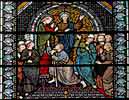 St Peter heals the St Peter heals theLame Man |
 Annunciation to Zechariah Annunciation to Zechariahand Annunciation to the Blessed Virgin |
This is the youngest of the O’Connor windows and dates from 1865. It has three sections, with the lower panel having two scenes:
 Christ in Glory displaying his wounds
Christ in Glory displaying his wounds
The upper panel shows Christ in Glory, displaying the wounds in his hands and feet.
 St Peter heals the Lame Man
St Peter heals the Lame Man
The centre of the panel is occupied by the lame man in front of St Peter, who is accompanied by St John.
 Annunciation to Zechariah (Left)
Annunciation to Zechariah (Left)
The priest is on duty in the Temple when he has a vision of the Archangel Gabriel, who told him that his aged wife Elizabeth would have a son to be called John.
Annunciation to the Blessed Virgin (Right)
The parallel image of the Archangel Gabriel informing Mary that she is to bear a son to be called Jesus.
This glass is clearly from a different era: the colours more subtle and pleasing to the eye than those used in the 1851 windows. The overall impression is of a cleaner and better defined work.
On a brass tablet beneath the window:
This window is dedicated to the |
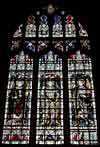 Caption Caption |
 Stained glass Stained glassin the tracery |
 Gabriel Gabriel |
 Michael Michael |
 Raphael Raphael |
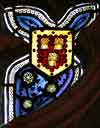 C E Kempe logo C E Kempe logo |
This is the Perpendicular window to the east of the font. It is by Kempe and Co and is dated 1898. Three wheatsheaves are to be seen on the left of the window and the artist is Alfred E Tombleson, Kempe and Co’s chief painter at the period.
The window shows the Three Archangels: Gabriel in the left-hand light, Michael in the centre light and Raphael in the right-hand light.
The dedication in the bottom right-hand corner of the glass reads:
To the glory of God and in memory of a |
10.A Perpendicular-style window inserted in the middle of the fifteenth century and filled with common glass
13-16.Perpendicular-style windows inserted in the middle of the fifteenth century and filled with common glass. The structure of these four windows is slightly different from the corresponding windows (9-12) on the south side of the nave.
South transept
 Window 17 Window 17 |
 Window 19 Window 19 |
 Window 21 Window 21 |
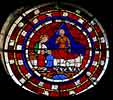 Window 22 Window 22 |
In the south wall are two Norman windows at ground floor level (Windows 17-18), two Norman windows at triforium level (Windows 19-20) and two circular windows at clerestory level (Windows 21-22). The glass in the Norman windows was installed by Keith Barley in 1999 and has stylized geometric patterns designed by Martin Stancliffe. The designs echo the O’Connor windows in the nave, with a patterned border and three roundels in the centre.
The Norman window above the south Door (Window 17) is not as deep as its partner in order to accommodate the door arch. It therefore has only two roundels in the geometric design.
The two circular windows at the clerestory level (Windows 21-22) are filled with coloured glass. They are by the Sutton Brothers, of Norwood Park, Southwell, talented amateur stained-glass artists, and date from 1850. There is no matching coloured glass in the corresponding circular windows in the north transept.
The Revd Algernon Sutton and the Revd Frederick Heathcote Sutton were the sons of Sir Richard Sutton, Bart. Windows by Canon Frederick Heathcote Sutton may be seen in the Church of St Helen, Brant Broughton, Lincolnshire, where he became the incumbent in 1873 and worked with G F Bodley to restore the interior. He designed the glass and made the windows using a workshop in his rectory.
The two circular windows in the minster depict Crossing the River Jordan into the Promised Land (on the left) and (it is said) The Healing of the Daughter of Jairus (on the right).
 Window 23 Window 23 |
 Window 24 Window 24 |
 Detail of Detail ofWindow 24 |
 Window 25 Window 25 |
In the west wall are two Norman windows at ground floor level (Windows 23-24), two Norman windows at triforium level (Windows 25-26) and two circular windows at clerestory level (Windows 27-28). The glass in the Norman windows was installed by Keith Barley in 1999 and has stylized geometric patterns designed by Martin Stancliffe. The designs echo the O’Connor windows in the nave, with a patterned border and three roundels in the centre.
The ground-floor Norman window nearest to the nave (Window 24) carries a glass design commemorating the Golden Jubilee of the Royal British Legion. It displays a patterned border and three roundels to match the other windows in the transept, and was designed and installed by Keith Barley in 1999, replacing a previous panel inserted in 1972. (The previous window was of common glass, with a small engraved panel at the bottom). This Royal British Legion window faces the war memorial.
The circular windows at the clerestory level (Windows 27-28) are of plain glass and match the windows on the south side of the nave at that level. They have a geometric pattern with a circular border.
North transept
 Window 30 Window 30 |
 Window 32 Window 32 |
In the north wall are two Norman windows at ground floor level (Windows 29-30), two Norman windows at triforium level (Windows 31-32) and two circular windows at clerestory level (Windows 33-34). The two ground floor windows are of equal height. The glass in the Norman windows was installed by Keith Barley in 1999 and has stylized geometric patterns designed by Martin Stancliffe. The designs echo the O’Connor windows in the nave, with a patterned border and three roundels in the centre.
The two circular windows at the clerestory level (Windows 33-34) are filled with plain glass and match those along the north side of the nave.
 Window 35 Window 35 |
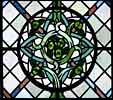 Detail of Detail of Window 35 |
In the west wall are two Norman windows at ground floor level (Windows 35-36), two Norman windows at triforium level (Windows 37-38) and two circular windows at clerestory level (Windows 39-40). The glass in the Norman windows was installed by Keith Barley in 1999 and has stylized geometric patterns designed by Martin Stancliffe. The designs echo the O’Connor windows in the nave, with a patterned border and three roundels in the centre.
The ground-floor Norman window nearest to the nave (Window 35) carries a glass design dedicated to the bicentenary of the Bramley Apple (1809-2009). This window, which features a similar patterned border and three roundels, was designed by Helen Whittaker and Keith Barley.
The circular windows at the clerestory level (Windows 39-40) are of plain glass and match the nave windows at that level.
The Pilgrim's Chapel
41-43.The Pilgrims Chapel has two windows on the east side (Windows 41-42) and one window on the north side (Window 43).
The two windows to the east are filled with common glass.
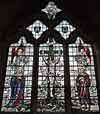 The window in the north wall (Window 43) is dedicated to the memory of Major John Pickard Becher D.S.O. of the Sherwood Foresters who was badly injured during an assault on the Hohenzollern Redoubt on 15 October 1915 and later died in hospital on 1 January 1916.
The window in the north wall (Window 43) is dedicated to the memory of Major John Pickard Becher D.S.O. of the Sherwood Foresters who was badly injured during an assault on the Hohenzollern Redoubt on 15 October 1915 and later died in hospital on 1 January 1916.
A service of dedication for the window, led by the Bishop of Southwell, was held on 13 October 1921.
An inscription at the bottom of the window reads:
For a remembrance before GOD |
This window is the most modern of the representations of the Crucifixion in the minster. The central panel shows our Lord on the cross with the Blessed Virgin on the left and St John on the right. He wears a crown of thorns and above his head on the upright member of the cross is the mocking label INRI ('Jesus of Nazareth King of the Jews'). Above the two panels are the letters alpha and omega – the first and last letters of the Greek alphabet – signs of the omnipotence of God. At the apex of the window is the pelican in its piety.
Until recently the window was assumed to be the work of the artist Sir William Nicholson (1872-1949), who was friendly with the Becher family, but it is now thought more likely that it is by the stained glass artist Archibald Keightley Nicholson (1871-1937).
The choir
 |
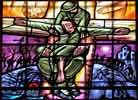 Detail Detail |
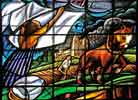 Detail Detail |
 Plaque Plaque |
This window is a single light, wider than the other lancets in the south choir aisle and located centrally in the westernmost bay of that aisle. It is the Great War Memorial window, commissioned from Nicholas Mynheer in 2014 and dedicated on 10 July 2016. Southwell Minster, which was the mother church for both Nottinghamshire and Derbyshire during the Great War, is depicted as an enduring symbol of stability. The design commemorates all those from both counties who lost their lives in the conflict, whilst paying tribute to civilians hard at work on the home front. Christian iconography merges with images of the horrors of the trenches: but forgiveness and reconciliation is the final message.
Beneath the window is a plaque with the prominent words 'Love, Pray, Remember'. It was designed and carved by Nicholas Mynheer. The letter-cutter was Bernard Johnson.
 |
 |
 |
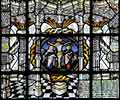 |
In the bottom right-hand corner of the glass is the following dedication:
For a remembrance before God of |
 |
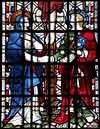 Detail Detail |
This window is a single panel in the left-hand half of the third bay of the aisle, whilst the companion panel to the right is filled with common glass. The painted window is by Clayton and Bell and was installed in 1876. It depicts The Crucifixion in a very similar manner to that shown in Window 50 in the Chapel of Christ the Light of the World.
A small plain brass below the string course reads:
| TO THE GLORY OF GOD AND IN MEMORY OF WILLIAM FOWLER SLEEPING IN JESUS JANUARY 29TH 1875 AGED 79 |
 |
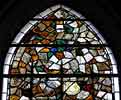 |
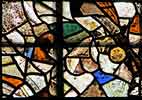 |
 |
This window is often referred to as 'The Patchwork window'. It was built up from scraps of medieval glass discovered in the room over the chapter house passage. A large “B” near the top of the window is for a man called Butler, who leaded the glass in 1920. For this reason, an alternative name for the window is 'The B window'. The window is in the right-hand half of the fourth bay. There is no corresponding window in the left-hand half of the bay, because of the presence of the enclosed staircase in the external angle between the aisle and the Chapel of Christ the Light of the World.
The Chapel of Christ Light of the World
 |
 The Risen Lord The Risen Lord |
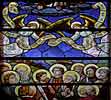 The apostles The apostles |
This window, on the western side of the Chapel of Christ the Light of the World, is by Burlison and Grylls and was installed in 1882. It depicts the Ascension. The Risen Lord is shown ascending into the heavens, clad in a ruby coloured robe, with the apostles gathered below. His footprints are shown left behind on the grass.
The dedication reads:
| + To the glory of God and in loving memory of James Dudley Cargill, B.D. Priest, Rector of Fretherne, Gloucestershire, and for sometime Head Master of the Collegiate Grammar School Southwell, who fell asleep in Christ October 2nd 1882, aged 59 years. |
The window is in the southern half of the west wall, to accommodate the enclosed staircase in the external angle between the chapel and the south choir aisle. This staircase is accessed via a small door in the north-west corner of the chapel.
 The Crucifixion The Crucifixion |
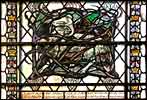 Detail Detail |
 St John St John |
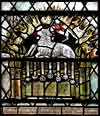 Detail Detail |
This window is by Christopher Whall and is the only one by him in the church. The son of a clergyman, Whall began designing stained glass windows, but found that his designs were not executed as he would wish. He taught himself the skills of stained glass work and became a leading member of the Arts and Crafts movement. This window was completed in 1906.
There are two separate panels. The one on the left shows the Crucifixion and the other depicts St John on Patmos. The inscription reads:
In piam memoriam Joannis Noble de Little Over in com: de Derby Arm[…] qui apud Kendal in com: de Westmorland die VII Apr:A:S:MDCCCXXVIII nat[…] |
St Oswald's Chapel
51.This window is in the south wall of St Oswald’s Chapel and is by C E Kempe (1885). It is a two-light window with different themes in the two panels:
 The Presentation in the Temple
The Presentation in the Temple
 |
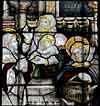 |
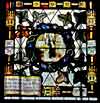 |
In the centre is the altar in the temple with the BVM at the left and Joseph on the right, holding the cage containing the sacrifice for the first-born. Simeon stands behind holding the baby Jesus.
The inscription at the bottom-left of the light reads:
| In thankfulness to God and in loving remembrance of Mary Burrill who died Ianuary 8th 1883 this window is dedicated. |
 Christ amongst the Doctors
Christ amongst the Doctors
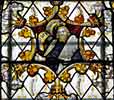 |
 |
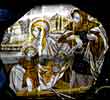 |
The panel depicts the story of Jesus accidentally left behind in the Temple after the Passover. Jesus reads from the scriptures and the teachers and elders are gathered round him. In the top corner his parents have just returned and are searching for him.
The inscription at the bottom-left of the light reads:
| To the glory of God and in memory of Robert Miles Rector of Bingham, Prebendary of Lincoln, Proctor in Convocation erected by subscription. 1885. |
 Detail Detail |
 Detail Detail |
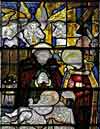 Detail Detail |
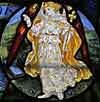 Detail Detail |
This window is in the east wall of St Oswald’s Chapel and is again by C E Kempe (1880). The single theme is The Adoration of the Shepherds and the two lancets are to be read as a whole. On the left are the shepherds carrying their crooks, the first of the three kneeling in adoration of the Christ-child, with his mother standing behind. Joseph stands alongside.
The inscription reads:
|
The sanctuary
 Detail Detail |
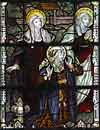 Detail Detail |
 Detail Detail |
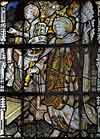 Detail Detail |
In the south wall of the sanctuary there is a two-light window by C E Kempe, dating from 1898, in memory of Eliza Watkin. The single subject is The Holy Women at the Tomb, but it goes across both lights. The three Marys who visited the tomb early on Easter Day are shown, together with the two angels, one at the head and one at the feet of the position where Jesus had lain.
The lower part of this window containing an inscription is obscured because the five-seat sedilia has been fitted across it, presumably after it was installed. It would seem that the sedilia was moved to its present position after 1898, but confirmation of this has not been established.
54.Contains the heraldic devices of some leading families in Nottinghamshire: Gally (for Mr Gally Knight of Warsop); Saville (for John Lumley Saville of Rufford Abbey): Middleton (for Lord Middleton of Wollaton Hall): and Manvers (for Charles, Earl of Manvers, of Thoresby Hall). Installed in 1825, it is by Joseph Hale Miller.
 |
 |
 |
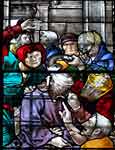 |
The four lower east windows were made originally for the Chapel of the Sacred Name of Jesus, which was added to the Temple Church, Paris in 1528. The artist is Jean Chastellain. The panels were found in a Parisian second-hand shop by Henry Gally Knight, a Nottinghamshire landowner, in 1815 and presented to the minster in 1818. They were incomplete and J H Miller restored and adapted them to fit.
57.![]() Contains the heraldic devices of some leading families in Nottinghamshire: Knight (for Mr Gally Knight of Warsop); Southerton (for Vice-Admiral Frank Southerton of Kirklington Hall); Sutton (for Sir Richard Sutton, of Norwood Park, Southwell); and Clinton (for Henry Pelham Clinton, Duke of Newcastle, of Clumber Park). Installed in 1825, it is by Joseph Hale Miller.
Contains the heraldic devices of some leading families in Nottinghamshire: Knight (for Mr Gally Knight of Warsop); Southerton (for Vice-Admiral Frank Southerton of Kirklington Hall); Sutton (for Sir Richard Sutton, of Norwood Park, Southwell); and Clinton (for Henry Pelham Clinton, Duke of Newcastle, of Clumber Park). Installed in 1825, it is by Joseph Hale Miller.
The Airmen's Chapel
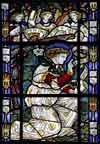 Detail Detail |
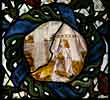 Detail Detail |
 Right light Right light |
 Detail Detail |
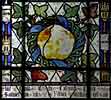 Detail Detail |
This window is in the east wall of the Airmen’s Chapel. It was installed in 1875 by C E Kempe. It depicts the Annunciation of the Blessed Virgin Mary and the roundels show Gideon and the Fleece and Moses and the Burning Bush.
The dedication, which is engraved on the glass and runs across both lights, reads:
|
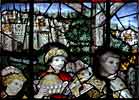 Detail Detail |
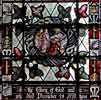 Detail Detail |
 Detail Detail |
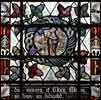 Detail Detail |
This window in the north wall of the Airmen’s Chapel was installed by C E Kempe in 1898. It has two lights, but they show one picture: the Adoration of the Magi. The two roundels depict the Magi seeing the star and the Magi journeying towards Bethlehem.
The dedication reads:
| To the glory of God and in dear memory of Mary Maltby who died December 4th 1890 these windows are dedicated. |
St Thomas's Chapel
 |
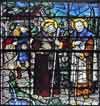 Joseph greeted Joseph greetedby Zechariah |
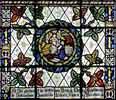 The Annunciation The Annunciationto Zechariah |
 |
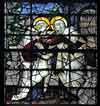 Mary greeted Mary greetedby Elizabeth |
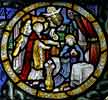 Annunciation to Annunciation tothe Blessed Virgin Mary |
In the east wall of the chapel, there is a two-light window, made in 1910, entitled The Visitation, showing the visit of Joseph and the Blessed Virgin to her cousin Elizabeth, who was to bear a son, the future St. John the Baptist. In the left-hand light Joseph is being greeted by Zechariah, whilst in the right-hand light Mary greets Elizabeth. The left-hand roundel shows the Annunciation to Zechariah, whilst the right-hand roundel depicts the Annunciation to the Blessed Virgin Mary.
The inscription along the bottom of the window reads:
|
 |
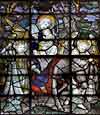 Donkey bearing Donkey bearingMary and Jesus |
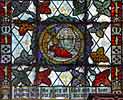 The Annunciation The Annunciationto Joseph |
 |
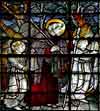 Joseph leading Joseph leadingthe small party |
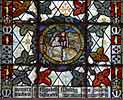 The Holy Family The Holy Familyresting during the journey into Egypt |
In the north wall there are two lights to be read together, showing The Flight into Egypt (1907). On the left, the donkey bearing Mary and Jesus is attended by angels carrying lanterns, whilst on the right Joseph, with his staff in his hand, is leading the small party, accompanied also by angels bearing lanterns. The left-hand roundel shows the Annunciation to Joseph, whilst the one on the right shows the Holy Family resting during the journey into Egypt.
The inscription along the bottom of both lights reads:
|
 |
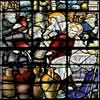 Jesus is sitting Jesus is sittingat table with his mother behind him |
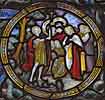 St John the Baptist St John the Baptist recognizing Jesus as the Messiah |
 |
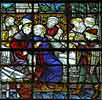 The guests at The guests atthe feast |
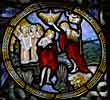 The Baptism The Baptism of Christ |
The third window, in the west wall is dated 1906 and depicts The Marriage at Cana. Once again there are two lights: the one on the right shows the guests at the feast, whilst on the left Jesus is sitting at table with his mother behind him. He is pointing at the stone jars, which a servant is filling with water. The left-hand roundel shows St John the Baptist recognizing Jesus as the Messiah, whilst the right-hand roundel is a representation of the Baptism of Christ. Jesus stands in the River Jordan and John anoints his head, pouring water from a shell.
The inscription along the bottom of the window reads:
|
The chapter house passage
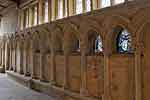 In the chapter house passage, on the east side, there are six roundels made by Patrick Reyntiens in 1996. It is clear from their style that they are by the same hand that made the west window.
In the chapter house passage, on the east side, there are six roundels made by Patrick Reyntiens in 1996. It is clear from their style that they are by the same hand that made the west window.
Beginning with the nearest one to the north choir aisle and working towards the chapter house entrance, they depict:
64.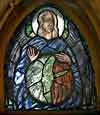 The Expulsion from the Garden of Eden
The Expulsion from the Garden of Eden
An angel on the left brandishes a flaming sword as Adam and Eve retreat on the right.
The chapter house
In the chapter house itself, there are many fragments which are thought to have come from other parts of the minster, and some which have come from other churches.
There are six windows and they are numbered in a clockwise rotation, beginning with the window to the left of the entrance arch.
70.
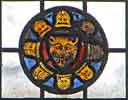 Eight leopards' Eight leopards' heads |
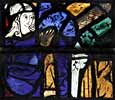 Praying woman Praying woman |
 'Suscip(e)' 'Suscip(e)' |
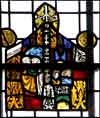 Detail Detail |
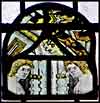 Detail Detail |
Left-hand light
 Eight leopards’ heads in a blue circle
Eight leopards’ heads in a blue circle
 Leopard’s head with tongue issuing
Leopard’s head with tongue issuing
 Woman in blue praying
Woman in blue praying
Centre light
 Visitation: figure in yellow and figure in white
Visitation: figure in yellow and figure in white
 Lombardic letters SUSCIP(E)
Lombardic letters SUSCIP(E)
 Two gold eagles
Two gold eagles
Right-hand light
 Adoration of Magi (considerably obscured)
Adoration of Magi (considerably obscured)
75.
 |
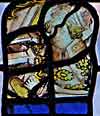 Bishop's head Bishop's head |
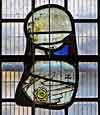 Gloved hand Gloved handof archbishop |
 Woman's head Woman's head |
 Mounted knight Mounted knight |
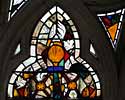 Glass in tracery Glass in tracery |
Left-hand light
 Roundel with 'HIS' in yellow stain on white
Roundel with 'HIS' in yellow stain on white
 Bishop’s head in mitre, amise and chasuble
Bishop’s head in mitre, amise and chasuble
Centre light
 White ermined dragon on blue
White ermined dragon on blue
 Female saint’s head. White whimple
Female saint’s head. White whimple
 Archbishop. Traces of mitre Gloved hand with embroidery on back and the pallium
Archbishop. Traces of mitre Gloved hand with embroidery on back and the pallium





